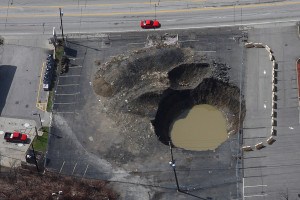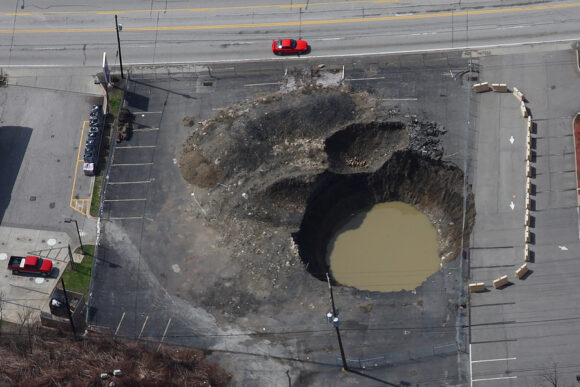“The head has been cut off the sinkhole monster,” said Curtis Hutchens, an in-house attorney for Florida’s Citizen’s Property Insurance Corp.
According to Hutchens, the new sinkhole statute (627.706) that went into effect on May 17, 2011 continues to evolve. That’s good news for adjusters, since the statute provides new rules that assist in sinkhole claims handling.
“The statute has given the industry tools to aggressively, fairly and reasonably settle sinkhole claims,” Hutchens said during a session on the topic held recently during the Property Loss Research Bureau (PLRB) national conference in Orlando, Fla.
 Hutchens defined a sinkhole as a land form created by subsidence when ground water dissolves limestone. He said that while there are all kinds of earth movement that can result in damage that is not a sinkhole; it is a major issue for Florida, which is made up entirely of limestone.
Hutchens defined a sinkhole as a land form created by subsidence when ground water dissolves limestone. He said that while there are all kinds of earth movement that can result in damage that is not a sinkhole; it is a major issue for Florida, which is made up entirely of limestone.
“A sinkhole is very specific. It’s about groundwater dissolving limestone and creating a void,” Hutchens said.
According to Andy Rock, an attorney with Rock Law Group, sinkhole lawsuits are being filed faster than ever before.
“The claims that create the litigation are subsidence claims,” Rock said. “How does it manifest? It looks a lot like cracks on a driveway.”
Sinkhole Claim Reduction
The presenters said the legislative intent of the statute is to reduce sinkhole disputes by reducing the cost associated with the disputes, relying on a technical definition and by compelling repairs.
Hutchens explained some important elements of the new law.
First, the time element has changed. There is now a time limit for reporting sinkhole claims; two years from the date of loss. Hutchens expects date of loss to become more of an issue in about 18 months, two years from the statute effective date.
Second, there is now a strict definition of the term “structural damage.” A technical requirement went into effect that requires floor displacement, structural wall displacement and substantial damage be incurred, as defined under the Florida business code, to meet the definition.
Third, the statute removes some incentives for attorney’s fees.
Fourth, the statute allows carriers to eliminate the cash out incentive which had been a driver for policyholders to make claims, according to the presenters.
Another benefit of the statute, according to Rock, includes an examination under oath (EUO) option.
“Some plaintiff attorneys will tell you that they win or lose the case after an EUO,” said Rock.
Neutral Evaluation Option
A neutral evaluation can be used as a way to assist resolution if sinkhole causation is disputed, Rock said. Much like an appraisal, an insured or insurer can request it. The difference is that a neutral evaluation in a sinkhole claim is not binding.
“It can tell you if you’re right or if you have exploitable data,” Rock said.
Unlike an appraisal, attorney fees in a neutral evaluation are limited to $2500.
Another benefit to neutral evaluation is that if a carrier participates, it has immunity from an extra contractual suit on issues resolved in the neutral evaluation.
“That’s an attorney fee driver that pushes some of these claims that is minimized or eliminated,” Hutchens said.
The option is not without its drawbacks. A neutral evaluator has a lot of power and freedom, Rock said. He or she has the power to hire engineers, a potential issue for a carrier watching expense dollars. On the flip side, a carrier can twice strike a neutral evaluator for no reason and any number of times for cause.
Because a carrier must inspect the property to determine if there is structural damage, Rock suggested creating a decision tree protocol to handle sinkhole claims. The protocol should establish who will make the structural damage determination; a field adjuster or an engineer.
Hutchens recommended carriers educate adjusters to make that determination, rather than hiring an engineer and incurring substantial costs.
Once a determination is made, the carrier must send the policyholder a report outlining its conclusions and offer the option of neutral evaluation, Hutchens said. If the insured wants testing done, he or she has 60 days to demand testing and must pay half of the fees up to $2500.
According to Hutchens, once the testing is completed and the insured has received the report, he or she has just 90 days to retain a repair contractor. A carrier only has to pay the actual cash value (ACV) until the insured enters into a contractor agreement, and then pays the contractor directly. Once repairs have begun they must be finished within 12 months, he said.
Rock pointed out that a carrier doesn’t owe a policyholder for stabilization costs until after a repair contract is in place.
Stabilization usually accounts for over half of the repair costs, he said.
“It’s an incurred coverage like additional living expense (ALE),” said Rock. “Insured has got to incur it first.”
Was this article valuable?
Here are more articles you may enjoy.


 JPMorgan Wins Gender Pay Gap Dispute Against London Analyst
JPMorgan Wins Gender Pay Gap Dispute Against London Analyst  Munich Re: Insured Losses From Wildfires, Storms and Floods Hit Record High
Munich Re: Insured Losses From Wildfires, Storms and Floods Hit Record High  California Bill Would Require Insurer Claims Handling Plans, And Double Penalties
California Bill Would Require Insurer Claims Handling Plans, And Double Penalties  Allianz Built An AI Agent to Train Claims Professionals in Virtual Reality
Allianz Built An AI Agent to Train Claims Professionals in Virtual Reality 